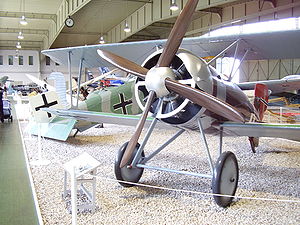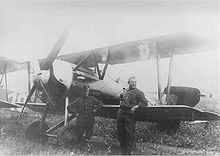Siemens-Schuckert D.IV Video - Picture

|
|
Siemens-Schuckert D.IV

Picture - D.IV replica displayed at Luftwaffenmuseum der Bundeswehr
Role: Fighter aircraft
National origin: Germany
Manufacturer: Siemens-Schuckert
First flight: 1918
Introduction: 1918
Primary user: Germany
The Siemens-Schuckert D.IV was a late-World War I fighter aircraft from Siemens-Schuckert (SSW). Considered by many to be the best fighter to see action during the war, it reached service too late and was produced in too few numbers to have any effect on the war effort.
Earlier designs
Siemens-Schuckert had entered the fighter-building business with an almost direct copy of the French Nieuport 17, the Siemens-Schuckert D.I. The plan was to equip it with an engine similar to the Nieuport's 80 CV (59 kW) Le Rhx´ne 9J, which was currently in production in Germany as the Oberursel UR.II. Supplies of the UR.II were extremely limited and none could be spared for SSW's production, so instead SSW decided to start production using their own engine, the Siemens-Halske Sh.I. D.I's were intended to be delivered in late 1915, but, the engine ran into significant delays. By the time they were ready for production in 1916, the design was no longer competitive. After a short run of 95 to be used as trainers, production of the D.I ended.
Siemens-Halske was unhappy with this turn of events, and started work on much larger engine designs to ensure they would not become outdated before entering service. One of these, the Siemens-Halske Sh.III, eventually matured into a workable design at 160 PS (120 kW). Rotary engines with this sort of power would normally lead to terrible handling problems due to high torque, as it did on the Sopwith Camel, but the design team at Siemens-Halske came up with a clever solution to this problem. By running the engine's major interior mechanisms (the crankshaft, connecting rods and pistons) in a clockwise direction as seen from "nose-on", and the crankcase and a very large prop in a counterclockwise direction, the torque was reduced to a large degree. Additionally, a 2:1 ratio set of bevel gears at the rear of the crankcase allowed the engine to run at 1,800 RPM while the propeller spun at 900, allowing for a much larger and more efficient propeller. Without the step-down gearing a rotary would normally run at the same speed as the propeller, forcing the designer to trade off efficiency in either the engine or prop.
The Sh.III led to all of SSW's existing designs being re-engined for testing. In the case of the D.I, this led to a series of three prototype machines in known as the D.II, D.IIa and D.IIb. The primary difference between them and the original D.I was a much rounder and wider front fuselage to hold the larger engine, leading to a rather stubby-looking aircraft which pilots later referred to as the flying beer barrel. Flight tests started in June 1917, and while the plane did not have a very high top speed, it outclimbed anything else in the air. The only serious concern was the extremely long landing gear needed to keep the huge 2-bladed prop clear of the ground.
D.III
Three more prototypes were ordered, two D.IIc's with shorter and longer span wings, and the D.IIe with the original sized wings. After completion in October 1917 the design proved to be worth producing, and in December an order for twenty long-span D.IIc's was placed with a smaller 4-bladed propeller that allowed for shorter landing gear legs. These aircraft, now known as D.III, started delivery in January and were followed by an order for thirty more in February.
All fifty were delivered to front-line units in May, where they proved popular. However after only 10 hours of service the engines started showing serious problems, overheating and eventually seizing. Although Siemens blamed the problem on the Voltol-based oil that was used to replace scarce castor oil used to lubricate the engine, the planes were withdrawn from service and replaced by Fokker D.VII's. When they were removed Rudolf Berthold, commander of JG.II, noted that he felt the Siemens fighter be made available again for front-line use as quickly as possible for, after elimination of the present faults, it is likely to be become one of our most useful fighter aircraft.
A version of the Sh.III passed a full 40-hour endurance test in June and the planes were cleared to return to service in July. In the meantime they had been upgraded with the addition of a new rudder, balanced ailerons and a cut-away cowling for better cooling. Some sources also claim that the original engines were replaced with the improved 200 PS (150 kW) Sh.IIIa engines. An additional thirty new aircraft with these features were also built and all eighty of the improved design soon entered service in home defense units where their high climb rates made them excellent interceptors.
D.IV

Picture - An unmarked D.IV, possibly a captured machine
Meanwhile the short-span D.IIc prototype had been further refined, and with narrower-chord upper and lower wings, using the Gx¶ttingen 180 airfoil, each of 1.00 meter dimension from leading to trailing edge, the performance improved noticeably, both in top speed and in climb rate. An order for this model, now known as the D.IV, was placed in March 1918, and followed with several additional orders as the qualities of the design became obvious. The planes started reaching operational units in August, but of the 280 ordered only 123 were completed by the end of the war, about half of those reaching operational units. In October 1918 it was officially described as superior by far to all single-seaters in use.
Although the short landing gear and limited prop clearance led to tricky landing, the plane was otherwise easy to fly. It had a very short take-off run, and at heights above 4,000 m (13,100 ft) was faster and more manoeuvrable than the Fokker D.VII, at that point considered by all to be the best aircraft flying. Its most notable feature was its phenomenal rate of climb and extremely high service ceiling-it could reach 6,000 m (19,700 ft) in less than 14½ minutes. In 36 minutes it could reach 8,100 m (26,600 ft), about 1,200 m (3,900 ft) higher than the Fokker's maximum altitude.
Production of the D.IV continued after the cease-fire, with many being sold to Switzerland where they operated into the late 1920s. With the signing of the Treaty of Versailles all aircraft production in Germany was outlawed, and the aircraft portion of SSW disappeared. Siemens-Halske remained, later reorganizing into Bramo.
Other variants
In May/June 1918 a sesquiplane derivative, the D.V, participated in the Adlershof trials, but was not built in quantity. A 'parasol' monoplane conversion, the D.VI, was also tested in 1919, later renamed as the E.I. A triplane series developed in parallel, the Dr.I series.
Operators
German Empire
Luftstreitkrx¤fte
Specifications (D.IV)
Data from German Aircraft of the First World War
General characteristics
Crew: 1
Length: 5.7m (18 ft 8½ in)
Wingspan: 8.35 m (27 ft 7ā…˛ in)
Height: 2.72 m (8 ft 11 in)
Wing area: 15.1 m² (163 ft²)
Empty weight: 540 kg (1,190 lb)
Loaded weight: 735 kg (1,620 lb)
Powerplant: 1x— Siemens-Halske Sh.III 11-cylinder geared rotary engine, 118 kW (160 PS)
Performance
Maximum speed: 190 km/h (103 knots, 119 mph)
Service ceiling: 8,000 m (26,200 ft)
Wing loading: 48.7 kg/m² (9.94 lb/ft²)
Power/mass: 0.16 kW/kg (0.099 PS/lb)
Endurance: 2 hours
Climb to 1,000 m (3,300 ft): 1.9 min
Climb to 6,000 m (19,700 ft): 15.5 min
Armament
2 x— 7.92 mm (0.31 in) LMG 08/15 machine guns
Bibliography
Gray, Peter, and Thetford, Owen. German Aircraft of the First World War. London:Putnam, 1962.
Munson, Kenneth. Aircraft of World War I. London: Ian Allen, 1967. ISBN 0 7110 0356 4.
Siemens-Schuckert D.IV Pictures
More airplane videos.
Source: WikiPedia